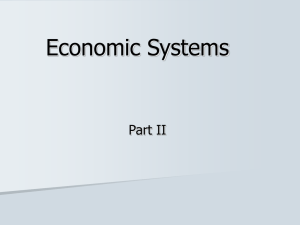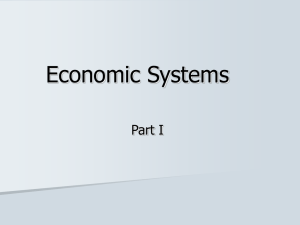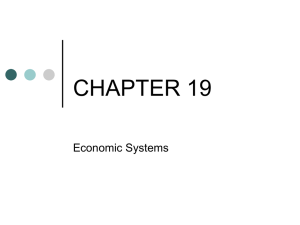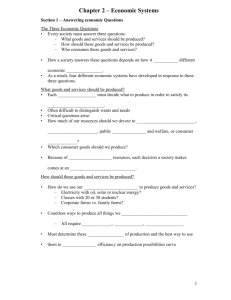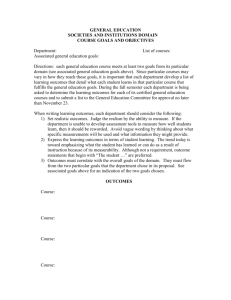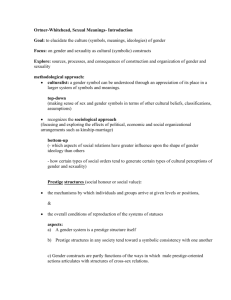Chapter 18, Economic Systems
advertisement
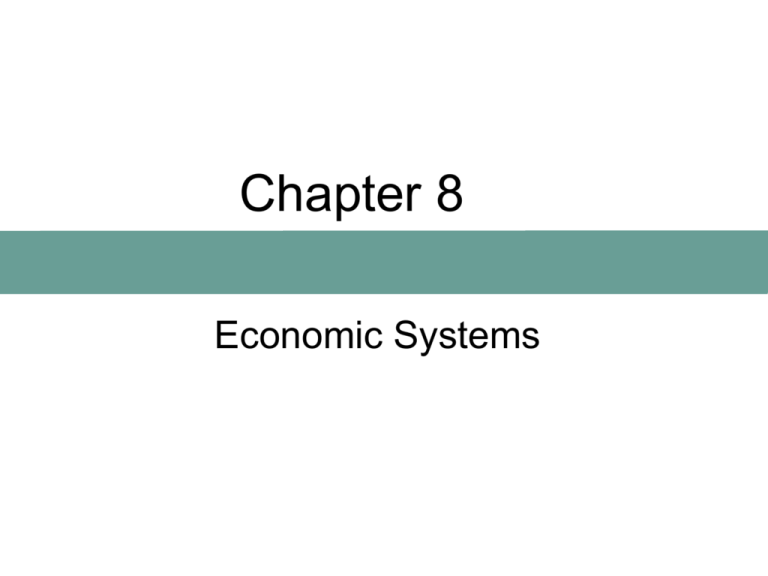
Chapter 8 Economic Systems Economic System A means of producing, distributing, and consuming goods. • All systems have: – Production – Exchange – Consumption • How Do Anthropologists Study Economic Systems? Anthropologists study how goods are produced, distributed, and consumed in the context of the total culture of particular societies. • Most anthropologists recognize that theories derived from the study of capitalist market economies have limited applicability to economic systems in societies where people do not produce and exchange goods for private profit. • How Do Societies Organize Economic Resources and Labor? • In small-scale nonindustrial societies valuable resources are usually controlled by groups of relatives. – Division of labor is by age and gender with some craft specialization. – Production takes place at the time required, and most goods are consumed by the group that produces them. How Do Societies Organize Economic Resources and Labor? • In large-scale industrial and postindustrial societies: – There is much a much more complex division of labor. – Individuals or business corporations own property. – Producers and consumers rarely know each other. Economic values Intermediate value - Use once • Social value – Subsistence – Prestige – Ceremonial • How And Why Are Goods Exchanged and Redistributed? • People exchange goods through: – Reciprocity – Redistribution – Market exchange Reciprocity Generalized - The value of what is given is not calculated and repayment is not specified. • Balanced -A direct obligation to reciprocate in equal value for the relationship to continue. • Negative - The giver tries to get the better of the deal. • Barter and Trade • • • Barter occurs when two or more partners from different groups negotiate a direct exchange of one trade good for another. Neither fair nor balanced, it may involve hard bargaining, manipulation, and outright cheating. Although in barter each party seeks to get the best possible deal, both may negotiate until a relative balance has been found, and each feels satisfied at having achieved the better of the deal. Redistribution Form of exchange in which goods flow into a central place where they are sorted, counted, and reallocated. • In societies with a sufficient surplus to support some sort of government, goods in the form of gifts, tribute, taxes, and the spoils of war are gathered into storehouses controlled by a chief or some other type of leader. • From there, they are handed out again. • Motives in Redistributing Income The leadership has three motives in redistribution: 1. Gain or maintain a position of superiority through a display of wealth and generosity. 2. Assure those who support the leadership an adequate standard of living by providing them with desired goods. 3. Establish alliances with leaders of other groups by hosting them at lavish parties and giving them valuable goods. Leveling Mechanism • A societal obligation compelling a family to distribute goods so that no one accumulates more wealth than anyone else. Ju/’hoansi Distribution • • These Ju/’hoansi are cutting up meat that will be shared by others in the camp. Food distribution practices of such food foragers are an example of generalized reciprocity. Market Exchange • • • • Buying and selling of goods and services, with prices set by rules of supply and demand. Money may be defined as something used to make payments for other goods and services. Its critical attributes are durability, portability, divisibility, recognizability, and fungibility. The wide range of things that have been used as money in one or another society includes salt, shells, stones, beads, feathers, fur, bones, and teeth. World Trade Organization • • A crowd of protesters demonstrating against World Trade Organization (WTO) policies that favor rich countries over poor ones during the organization’s December 2005 meeting in Hong Kong. Established in 1995 and headquartered in Geneva, the WTO is the only global international organization with rules of trade among its 150 member countries. Conspicuous Consumption • A term coined by Thorstein Veblen to describe the display of wealth for social prestige. Money Anything used to make payments for other things (goods or labor) as well as to measure their value; may be special purpose or multipurpose. • Limit money – can only buy certain items • You can store money • You can wear money • Informal Economy • The production of marketable commodities that for various reasons escape enumeration, regulation, or any other sort of public monitoring or auditing. Prestige Economy • Creation of a surplus for the express purpose of gaining prestige through a public display of wealth that is given away as gifts. World Systems Theory • No place in the world is economically isolated. Resources • Resources used to produce goods and services include: – Raw materials – Labor – Technology Control of Land and Water Resources All societies regulate allocation of valuable natural resources—especially land and water. • Food foragers determine who will hunt game and gather plants in their home range and where these activities take place. • Farmers must have some means of determining title to land and access to water for irrigation. • Control of Land and Water Resources Pastoralists require a system that determines rights to watering places and grazing land. • In Western capitalist societies, private ownership of land and rights to natural resources generally prevails. • The Yam Complex in Trobriand Culture • • Trobriand Island men devote a great deal of time and energy to raising yams, not for themselves but to give to others. These yams, which have been raised by men related through marriage to a chief, are about to be loaded into the chief’s yam house. Technology Resources Tools and other material equipment, together with the knowledge of how to make and use them, constitute a society’s technology. • Food foragers and nomads who are frequently on the move are apt to have fewer and simpler tools than sedentary farmers. • The primary tools for horticulturists include the axe, digging stick, and hoe. • Patterns of Labor Every society has a division of labor by gender and age. • This is an elaboration of patterns found among monkeys and apes. • Division by gender makes learning more efficient. • Division by age provides sufficient time to developing skills. • Division of Labor by Gender • Often, work that is considered inappropriate for women (or men) in one society is performed by them in another. Here we see female stone construction laborers in Bangalore, India, who carry concrete atop their heads. Three Patterns of Division of Labor by Gender • • • Flexible/integrated pattern Segregated pattern Dual sex Configuration Flexible/Integrated Pattern 35% of tasks are performed equally by men and women. • Tasks deemed appropriate for one gender may be performed by the other. • Boys and girls grow up in much the same way and learn to value cooperation over competition. • Segregated Pattern Almost all work is defined as masculine or feminine. • Men and women rarely engage in joint efforts. • Common in pastoral nomadic, intensive agricultural, and industrial societies. • Both boys and girls are raised primarily by women. • Dual Sex Configuration Men and women carry out their work separately. • The relationship is one of balanced complementarity rather than inequality. • Each gender manages its own affairs, and the interests of both men and women are represented at all levels. • Division of Labor by Age • • This Thai girl exemplifies the use of child labor in many parts of the world, often by large corporations. Even in Western countries, child labor plays a major economic role. The Kula Ring • The ceremonial trading of shell necklaces and armbands in the Kula ring encourages trade throughout Melanesia. The Kula Ring • In Melanesia, men of influence paddle and sail within a large ring of islands in the southwestern Pacific off the eastern coast of Papua New Guinea to participate in the ceremonial trading of Kula shells, which smoothes trade relations and builds personal prestige. Potlach • A ceremonial event in which a village chief publicly gives away stockpiled food and other goods that signify wealth. Potlach • • Among Native Americans living along the northwest coast of North America, one gains prestige by giving away valuables at the potlatch feast. Here we see Tlingit clan members dressed in traditional Chilkat and Raven’s Tail robes during a recent potlatch in Sitka, Alaska.
